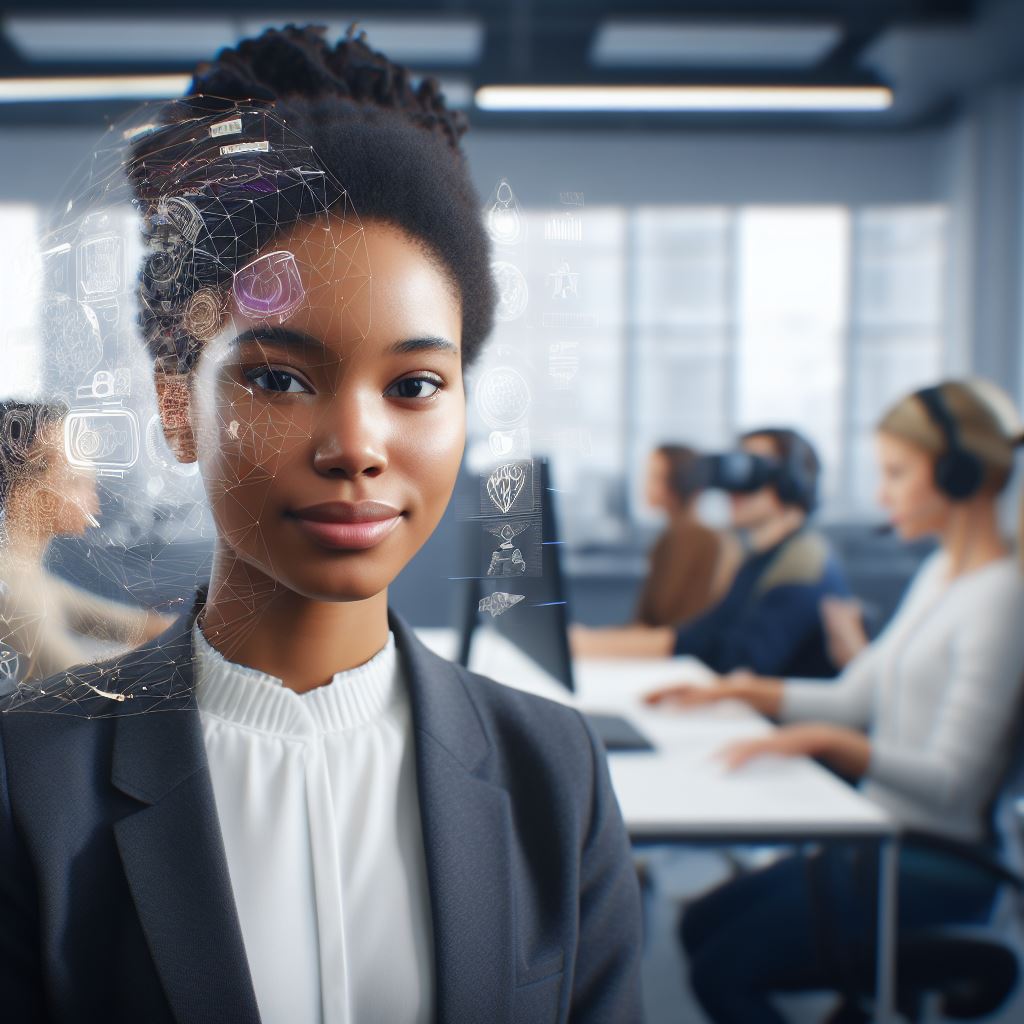Introduction
Unity is a powerful game development engine widely used for creating virtual reality experiences.
Virtual reality technology immerses users in a computer-generated environment, giving them a sense of presence and interaction.
This blog post aims to serve as a comprehensive guide for developers interested in using Unity for virtual reality development.
Unity, developed by Unity Technologies, allows creators to develop interactive and immersive experiences across various platforms, including virtual reality.
Virtual reality technology utilizes head-mounted displays and controllers to create a fully immersive experience for users, transporting them to digitally-created worlds.
It offers immense potential for gaming, training, simulations, and other applications.
The purpose of this blog post is to provide readers with a step-by-step guide on using Unity for virtual reality development.
It will cover various topics, including setting up a VR project in Unity, integrating VR-specific components, implementing user interactions, optimizing performance, and deploying the project to VR platforms.
By the end of this guide, readers will have a comprehensive understanding of how to leverage Unity’s features and tools to create compelling and immersive virtual reality experiences.
Whether you are a beginner or an experienced developer, this guide will equip you with the necessary knowledge and resources to start building your own virtual reality projects using Unity.
So, let’s dive into the exciting world of Unity and virtual reality development!
Getting Started with Unity and Virtual Reality
Importance of setting up a development environment
Setting up a development environment is crucial when working with Unity and virtual reality.
It ensures that all the necessary tools and resources are readily available, allowing for a smooth and efficient development process.
Setting up the development environment is the first step towards creating captivating virtual reality experiences.
It involves ensuring that all the necessary software and hardware components are in place, enabling seamless development and testing.
Tech Consulting Tailored to Your Coding Journey
Get expert guidance in coding with a personalized consultation. Receive unique, actionable insights delivered in 1-3 business days.
Get StartedOverview of Unity’s compatibility with different VR platforms (e.g., Oculus Rift, HTC Vive, PlayStation VR)
Unity is a versatile platform that is compatible with various virtual reality devices such as Oculus Rift, HTC Vive, and PlayStation VR.
This compatibility allows developers to target a wider audience and create immersive experiences across different platforms.
Unity’s compatibility with different VR platforms is a significant advantage for developers. It allows them to target specific devices and optimize their applications accordingly.
Whether it’s Oculus Rift, HTC Vive, or PlayStation VR, Unity provides the necessary tools and functionalities to create immersive experiences on these platforms.
Installing Unity and necessary plugins for VR development
To begin developing virtual reality applications in Unity, it is essential to have Unity installed on your computer.
Additionally, there are specific plugins and add-ons that need to be installed to enable VR development within Unity’s ecosystem.
Once Unity is installed, developers need to install additional plugins specifically designed for VR development.
These plugins enhance Unity’s capabilities, enabling developers to work efficiently and effectively on their virtual reality projects.
Some of the popular VR development plugins for Unity include SteamVR, Oculus Integration, and PlayStation VR SDK.
These plugins provide developers with access to device-specific functionalities and APIs, making it easier to create interactive and immersive virtual reality experiences.
In addition to the plugins, developers should also explore Unity’s built-in VR features and tools.
Unity provides a range of features like VR cameras, input systems, and spatial audio, which simplify the development process and enhance the overall quality of the virtual reality experience.
When setting up a development environment for Unity and virtual reality, it is crucial to ensure that your hardware meets the minimum requirements.
VR development can be resource-intensive, and having a powerful computer with a compatible graphics card is essential for smooth development and testing.
Build Your Vision, Perfectly Tailored
Get a custom-built website or application that matches your vision and needs. Stand out from the crowd with a solution designed just for you—professional, scalable, and seamless.
Get StartedFurthermore, it is recommended to have a dedicated VR device for testing purposes. This allows developers to experience their applications firsthand and identify any issues or areas of improvement.
In essence, setting up a development environment is essential for working with Unity and virtual reality.
It provides developers with the necessary tools and resources to create immersive experiences on various VR platforms.
By installing Unity, the relevant plugins, and optimizing the hardware setup, developers can embark on a rewarding journey of VR development.
Read: The Ethics of AI and Coding Robots: What You Should Know
Understanding Unity’s VR Features and Components
Unity, the popular game engine, offers robust support for developing virtual reality (VR) experiences.
In this section, we will explore Unity’s native VR support, important VR components, and Unity’s XR Interaction Toolkit for simplified VR interactions.
Explanation of Unity’s Native VR Support
Unity provides built-in support for VR, allowing developers to create immersive experiences without extensive coding.
With Unity’s native VR support, developers can easily integrate VR functionality into their projects.
Overview of Important VR Components
1. VR Cameras
VR cameras are essential components in Unity VR projects. They define the player’s point of view and allow for an immersive first-person experience.
Unity offers various VR camera options, including monoscopic and stereoscopic cameras.
2. VR Controllers
VR controllers enable users to interact with the virtual environment. Unity supports various VR controllers, such as Oculus Touch, HTC Vive controllers, and PlayStation Move controllers.
These controllers provide precise tracking and input capabilities for a realistic VR experience.
3. VR Input
Unity’s VR input system allows developers to map physical inputs from VR controllers to in-game actions.
Optimize Your Profile, Get Noticed
Make your resume and LinkedIn stand out to employers with a profile that highlights your technical skills and project experience. Elevate your career with a polished and professional presence.
Get NoticedThis enables users to interact with objects and perform actions within the VR environment. Unity’s input system simplifies the process of handling input events from VR controllers.
Introduction to Unity’s XR Interaction Toolkit
Unity’s XR Interaction Toolkit is a powerful package that simplifies VR interactions and development. It provides a collection of tools and components for easily creating interactive VR experiences.
The XR Interaction Toolkit is designed to work with a variety of VR platforms and supports Unity’s Universal Render Pipeline (URP) and High Definition Render Pipeline (HDRP).
Features of the XR Interaction Toolkit
- Interactable Objects: The toolkit allows developers to define objects in the VR environment that can be interacted with.
These objects can have different interaction behaviors, such as grabbing, throwing, or pressing. - Interactors: Interactors are components that represent the user’s hand or any other interactive object. They handle interactions with VR objects, enabling users to grab, touch, or manipulate them.
- Event System: The XR Interaction Toolkit includes an event system that facilitates communication between interactable objects and interactors.
Developers can create events triggered by specific interactions, allowing for dynamic and responsive VR experiences. - Interaction Managers: Interaction managers handle the overall management of interactions in the VR environment.
They control the activation and deactivation of interactors and handle collision detection and physics simulation. - XR Rig: The XR Rig prefab provided by the XR Interaction Toolkit sets up the necessary VR camera and player controllers.
It ensures a smooth and consistent VR experience across different platforms and devices.
In fact, Unity’s native VR support, VR components like cameras and controllers, and the XR Interaction Toolkit make it a comprehensive development platform for virtual reality experiences.
With these tools and features, developers can create immersive and interactive VR worlds, bringing their ideas to life in a visually stunning and engaging manner.
Read: Learn Julia for High-Performance Scientific Computing
Building a VR Scene in Unity
Step-by-step guide for creating a new VR project in Unity
- Launch Unity and create a new project by clicking on “New” in the Unity Hub.
- Name your project and choose a location to save it.
- Select the 3D template for your project, as we will be working with 3D assets in VR.
- Set the project to support Virtual Reality by going to Edit > Project Settings > XR Plugin Management.
- Enable Virtual Reality Supported and add the VR platforms you want to target (e.g., Oculus, HTC Vive).
- Save the settings and close the project settings window.
Setting up the VR scene with appropriate settings and scale
- Open the Unity project and create a new scene by going to File > New Scene.
- To create a VR scene, change the camera’s projection to perspective and set the near and far clipping planes.
- Attach the VR camera rig to the scene by importing the necessary assets or downloading them from the Unity Asset Store.
- Adjust the scale of your VR scene to match the real-world dimensions. Use measurement units such as meters or feet.
- Ensure that the VR camera rig is set up correctly, with the left and right eye cameras positioned correctly for a stereoscopic effect.
- Set up tracking devices if necessary, such as controllers or base stations, to enable user interaction within the VR scene.
Importing 3D assets and optimizing them for VR
- To import 3D assets, go to Assets > Import New Asset and select the desired files.
- Ensure that the imported assets are optimized for VR by checking their polygon count and reducing it if necessary.
- Apply proper textures and materials to the 3D assets to enhance their visual fidelity within the VR scene.
- Optimize the assets for performance by reducing the number of draw calls and using level of detail (LOD) techniques.
- Use Unity’s built-in VR optimization tools, such as Occlusion Culling and Asset Bundles, to improve performance.
- Test the VR scene on different devices and platforms to ensure compatibility and performance across the board.
In short, building a VR scene in Unity requires a step-by-step approach to create a new project, set up the scene with the right settings and scale, and import and optimize 3D assets for VR.
By following these guidelines, you can create immersive and interactive VR experiences using Unity. Happy VR scene building!
Read: How to Build a Multiplayer Game in Unity: A Tutorial

Implementing VR Interactions and Mechanics
In this section, we will explore different techniques for implementing VR interactions and mechanics in Unity.
We will cover locomotion techniques, object interactions using Unity’s XR Interaction Toolkit, and VR-specific mechanics such as UI elements and grab and throw physics.
Introduction to VR Locomotion Techniques
One of the key challenges in VR development is creating a comfortable and immersive movement system. Two popular locomotion techniques are teleportation and smooth movement.
Teleportation allows users to instantly move between different locations in the virtual environment by pointing and clicking.
Smooth movement provides a more natural walking or running experience but can cause motion sickness if not implemented correctly.
Choosing the right locomotion technique depends on the context of the VR experience and the comfort level of the users.
Utilizing Unity’s XR Interaction Toolkit for Object Interactions
Unity’s XR Interaction Toolkit provides a set of components and systems that enable developers to easily implement object interactions in VR.
With the XR Grab Interactable component, developers can define objects that can be picked up and manipulated by the user.
The XR Socket Interactor component allows for placing objects in specific locations or sockets in the virtual environment.
The XR Interactor Line Visual component displays a line to indicate the interaction range and helps users understand which objects are interactable.
By utilizing these components, developers can create intuitive and immersive object interactions in their VR experiences.
Implementing VR-Specific Mechanics
In addition to locomotion and object interactions, there are other VR-specific mechanics that can enhance the user experience.
- UI Elements: In VR, UI elements need to be carefully designed to be easy to read and interact with in a 3D space.
- Grab and Throw Physics: By implementing realistic physics for object grabbing and throwing, developers can create a more immersive and interactive VR experience.
It’s important to consider the limitations of the hardware and the comfort of the users when implementing these mechanics.
Implementing VR interactions and mechanics is a crucial aspect of creating immersive and engaging VR experiences.
By understanding locomotion techniques, utilizing Unity’s XR Interaction Toolkit, and implementing VR-specific mechanics, developers can create unforgettable VR experiences that captivate their users.
Read: How Coding Robots Help Improve Logical Thinking Skills
Optimizing and Testing a VR Experience
When it comes to developing a virtual reality (VR) experience using Unity, optimizing performance is crucial.
In this section, we will explore the importance of performance optimization for VR, techniques for optimizing VR projects in Unity, and the process of testing and fine-tuning the VR experience on target platforms.
Importance of Performance Optimization for VR
VR experiences require a high level of performance to ensure a smooth and immersive user experience.
Any lag or frame rate drop can lead to discomfort and disorientation for the user, impacting the overall quality of the VR experience. Therefore, optimizing performance is vital.
First and foremost, it is important to optimize the rendering pipeline. Unity provides various tools and techniques to achieve this.
One effective technique is level of detail (LOD) optimization, where objects in the scene are rendered with different levels of detail based on their distance from the user’s viewpoint.
This helps reduce the rendering workload and improves performance.
Another crucial technique is occlusion culling. By determining which objects are currently visible to the user and only rendering those, unnecessary rendering computations can be avoided.
This significantly improves performance, especially in complex scenes with many objects.
Techniques for Optimizing VR Projects in Unity
In addition to LOD optimization and occlusion culling, there are several other techniques that can be employed to optimize VR projects in Unity:
- Use asset bundling to reduce build size and load times.
- Implement efficient collision detection and physics calculations to reduce overhead.
- Optimize shader usage and complexity to reduce GPU workload.
- Minimize draw calls by combining objects into a single mesh where possible.
- Utilize GPU instancing to render multiple instances of the same object efficiently.
By utilizing these techniques, developers can efficiently optimize their VR projects in Unity, ensuring a seamless and immersive experience for the users.
Testing the VR Experience on Target Platforms and Fine-tuning
Once the VR project is optimized, it’s essential to thoroughly test it on target platforms to identify any performance issues or compatibility problems.
Unity provides built-in tools for testing and profiling VR experiences.
During testing, pay attention to frame rate, latency, and overall performance. It’s important to ensure that the VR experience runs smoothly and consistently on different devices and platforms.
Furthermore, gathering feedback from users during the testing phase can provide valuable insights for fine-tuning the VR experience.
User feedback can help identify areas for improvement and potential optimizations, leading to a more refined and enjoyable VR experience.
In review, optimizing and testing a VR experience in Unity is a critical step in delivering a high-quality, immersive experience for users.
By implementing performance optimization techniques and thorough testing on target platforms, developers can ensure that their VR projects perform well and provide a seamless experience for users.
Publishing and Distributing a Unity VR Project
Overview of the publishing process for different VR platforms
Each VR platform has its own requirements and guidelines for publishing a Unity VR project.
Understanding these specifications is crucial for successful deployment.
Submitting the VR project to respective stores or platforms
Once the project is ready, developers need to follow the submission process specific to each VR platform.
This often includes providing necessary files, descriptions, and assets.
Tips for marketing and promoting a VR project to reach the target audience
- Define your target audience: Identify who will benefit the most from your Unity VR project. Consider demographics, interests, and preferences.
- Create compelling promotional content: Generate engaging videos, screenshots, and graphics that highlight the unique features and experience of your VR project.
- Utilize social media platforms: Reach out to potential users through popular social media channels. Share updates, behind-the-scenes footage, and teasers to create excitement.
- Collaborate with influencers and VR communities: Partner with influential individuals in the VR industry who can promote your project effectively.
Engage with VR communities to gain visibility and gather feedback. - Offer demos and free trials: Allow users to experience a portion of your VR project for free. Demos and trials can attract interest and encourage potential users to make a purchase.
- Get featured on VR blogs and publications: Pitch your project to VR-focused blogs and publications. Positive reviews and articles can significantly increase visibility and credibility.
- Attend VR conferences and events: Participate in VR conferences and events to showcase your Unity VR project. Networking with industry professionals and enthusiasts can lead to valuable opportunities.
- Encourage user reviews and testimonials: Ask users to share their experiences and reviews about your VR project. Positive feedback can build trust and attract new users.
- Optimize for search engines and app stores: Research and use relevant keywords and tags to enhance the discoverability of your VR project in search engines and app stores.
- Monitor and analyze user feedback and metrics: Regularly analyze user feedback and metrics to understand the success and areas for improvement in marketing and promoting your Unity VR project.
Conclusion
In this blog post, we have covered several key points about using Unity for Virtual Reality.
We have discussed the importance of Unity in creating immersive VR experiences and the benefits it brings to developers.
Also, we have explored the various features and tools that Unity provides specifically for VR development, such as the Unity XR Plugin Management, the Unity Editor VR, and the support for different VR platforms.
We have also touched upon the challenges that developers may face when integrating VR into their Unity projects and provided some tips and best practices to overcome them.
Now it’s time for you, dear reader, to start exploring Unity for VR development! With its extensive support and powerful features, Unity offers endless possibilities for creating compelling virtual reality experiences.
Whether you are a beginner or an experienced developer, Unity is a great platform to dive into the world of VR development. Don’t be afraid to experiment and push the boundaries of what is possible in virtual reality.
To further enhance your knowledge and skills, we recommend checking out some additional resources and further reading materials.
Unity’s official documentation and tutorials are excellent starting points. You can also explore online forums and communities dedicated to VR development using Unity.
By continuously learning and experimenting, you will become proficient in Unity VR development and be able to create amazing virtual reality experiences that will captivate and engage users.
So what are you waiting for? Start your journey into Unity for VR development today and let your imagination run wild in the world of virtual reality!




